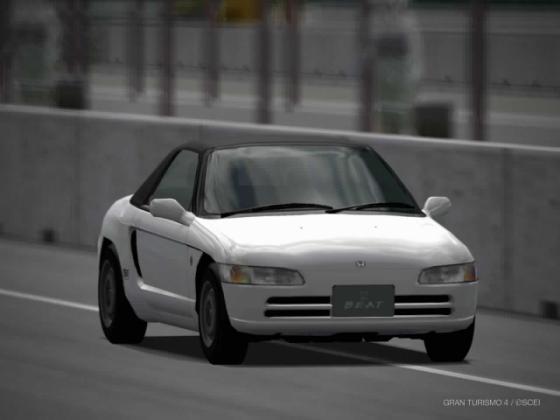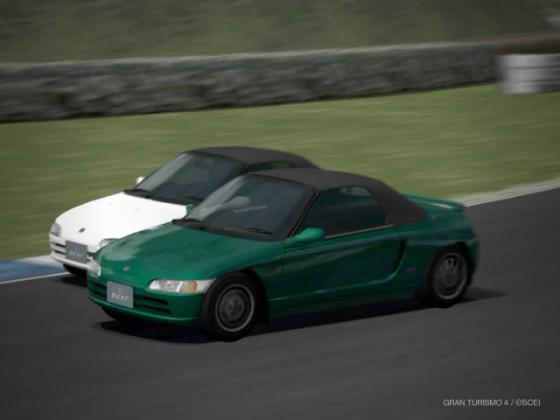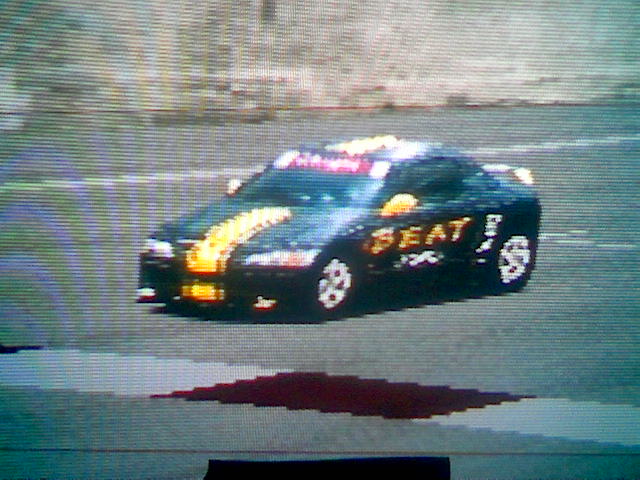|
SPEX
Years Represented: 1991-1994
Class: Kei
Type: roadster
Country: Japan
Host: GT2 & GT4
Price as Tested: $9,246 (model F--GT2), $6,940 (model F--GT4)
Construction: unit steel
Length: 129.7"
Width: 55.0"
Height; 46.25"
Wheelbase: 89.8"
Overhang: @3' 3.5"
Track: 47.6" front &
rear
Ground Clearance: 5.3"
Weight: 1,675 lbs. (all versions)
Weight Distribution: 43/57
Layout: Mid Engine / Rear Drive
Tires: 155/65R-13 [F] 165/60R-14 [R]
Suspension: MacPherson struts / coils / anti-roll
bar in front only.
Brakes: solid discs
Engine: 656 cc DOHC inline 3
Aspiration: normal
```````````````````````GT2```````````````````````````````GT4```````
Tested HP: 62
@ 7,900 rpm 63 @ 8,100 rpm
Tsd Torque: 44
@ 7,000 rpm 44 @ 7,000 rpm
Lbs per HP: 27.0
26.58
Hp per Liter: 94.5
96.0
Credits per HP: $149.13
$109.52
Fuel System: PGM-Fi
Valves per Cyl: 4
Bore x Stroke: 2.60 x 2.52"
GT2 Redline: 8,000 // Rev Limit: 9,000
GT4
Idle: 1,000 // Redline: 8,500 // Rev Limit: 9,000
Compression: 10.0:1
Transmission: 5-speed manaul
Differential: open
``````````````````````GT2`````````````````````````````GT4`````````
0-60 mph: 17.445 seconds 15.866 seconds
0-100mph: 58.047
seconds 47.316 seconds
400 M: 21.530 @ 65 mph
21.358 @ 69 mph
1 Kilom: 39.002 @ 86 mph 37.641 @
97 mph
Test Track: 3:10.xxx
no test
100-zero mph: no test 4.68 seconds
GT2 Top Speed at Redline
1st: 25 mph
2nd: 40 mph
3rd: 55 mph
4th: 75 mph
5th: 101.89 mph
@ 8,700 rpm (RPM limited)
GT4 Top Speed at Redline
1st:
26 mph
2nd: 44 mph
3rd: 61 mph
4th: 82 mph
5th: 107.56 mph @ 9,000 rpm (RPM limited)

|
| base model |

|
| Version F |
------------------EXTERIOR / HISTORY------------------
This car will make most kids and adults curious when they first see it, and its low price
will prompt many to buy one when they pop their Gran Turismo 2 or 4 disc in. The Beat looks like it will be fun,
sporty, and easy to drive, but let's read on and get the full story, shall we?
The 2-seater Honda Beat was built from May '91 until February of 1996. A total of 33,600
were made, and most of them (about 2/3rds of them) were built in the first year of production. Three of the four models
in the games are almost identical to each other under the skin in real life...but they boast subtle cosmetic differences.
In Gran Turismo 2, we have four versions available...and in GT4, PD scaled back some, as there are three (rather
than four) versions clamoring for our attention: the base car, the Version F, and the Version Z.
The Model J is the most basic car. In addition, there are Versions F, C, and Z in GT2. Version F was
a limited production car (just 800 were built) that could be bought in a metallic green color with white aluminum alloy wheels.
Only 500 Version Cs were made and these came in metallic blue. The version Z was the best of the three: it was silver or dark
green, and one could get ABS brakes or a limited-slip differential as options. Incidentally, you may need both
when you go and race...
Here we have a cute machine, 129" in length, 55" wide, and only 46 ¼" high. The Honda Beat follows in
the footsteps of other Japanese micro sports with its tiny dimensions and light weight. It's a sporty-looking thing, with
mid engine / rear drive layout and 2 seats. And really, it looks like something straight out of anime; to be driven by those
who still collect Hello Kitty and Piccachu paraphernalia.
I can't help but compare the Beat to a first-gen SW20 Toyota MR2 (also found in GT2
and 4), but aside from looks and engine layout, the two vehicles have little in common. In GT2, price ranges from $7,000
to around $10,000; in GT4 you'll be paying less; typically anywhere from $3,000 to $7,000. However, one should be aware from
the get-go how much money and time will be needed before the Beat can be made competitive, depending which game
you've got. Sporty looks can be deceiving, and in this case, they ARE deceiving!
The color schemes of the Beat are interesting and unique. And it's nice to see that not all the micro-cars
in GT are mini-vans or hatchbacks. At only 1,675 pounds, it seems you won't need to spend any money on weight
reductions, right? Uh....
--------------------ENGINE / DRIVETRAIN-------------------
The engine is another 3-cylinder bit of aluminum that seems like it would be more at home
in a sewing machine. Really, I know it is small, but 0 to 60 in 16 seconds and 0-100
in just under a minute is ridiculous. So it is obvious that despite its small size and
light weight, it's gonna need lots of help...starting right here.
Any competent car enthusiast will know the pound to weight ratio is pretty high. Even racing this car at
Tahiti's Sunday Cup (GT2) can become a nightmare: you might as well be behind the wheel of a tractor. On the other hand,
GT4's Beginner premier slow events (Sunday Cup and Lightweight K-Cup) aren't as demanding, and won't require the need
to fork over as much cash.
Since the Beat is a normally-aspirated vehicle, one of our first purchases in GT2 will be Stage 1 parts,
and you've got a choice of either turbo or normal tuning. Either way you're stuck: there
is no Stage 2. If you're gonna actually make the choice, go with the turbo. After adding this + the other usual
upgrades, the Beat!'s measly 63 horsepower will have been just about doubled. GT4 has three turbos for sale, no intercoolers,
and no NA upgrades. In this game, the Beat can make just under 140 horses at max.
Needless to say, after mods, it will still be nightmarishly slow, but it will at least have more pep.
Most folks may want to skip engine balancing and port / polish...both services cost about $15,000
and altogether provide an amazing 3 extra horsepower.
The standard 5-speed gearbox is useful for awhile. With a top speed of 101 mph, either
of the close ratio gearboxes will jeopardize the chance to get this car down straightaways without revving out,
so reserve a close-ratio box for a twistier course or for the Kei Car races or the prestigious Honda Beat Cup. Honestly,
it's rare either gearbox will be needed. The racing gearbox is a better (and necessary) buy if you actually
wanna take the Beat outside of these super-slow races.
Revs go extremely high...quite frankly this is an amazing
feat Honda managed to pull off. I'm not sure if there's a VTEC system here of any sort, but certainly the idea of high revs,
peak torque & horsepower showing up just before redline is an ideal Honda had in mind. Notice all of their VTEC cars also
have this ideal. Then again, other performance-oriented kei machines manage to also rev quite high.
At the Test Track, the Beat goes on...(bad joke...couldn't
resist). My Beat overrevved down the straight--8,800 rpms and the
tach needle made pretty good friends during the frightening 3 minute 10 second run around the entire course! For whatever
reason, the Beat is 7 mph faster in GT4.
--------------------CHASSIS / HANDLING-----------------
GT2
Okay, now here's the deal! The mid-engine layout makes this one absolutely horrible
to drive. Seriously, I nicknamed this car 'The Crab' due to its habit of skittering sideways thru corners. This happens during
MILD driving, not anything too rough!
The addition of sports tires plus the subtraction of weight will NOT help much. The only event this roadster
safely has a chance of winning is the actual Honda Beat Manufacturer's event races. Seriously. The Beat! will be easily
pummeled by the FWD and AWD competition it faces amongst its own weight class in the Kei Car Cup. It has a 43/57 weight distribution
front to rear--not out of the ordinary for a mid-engine car, yet when it starts sliding thru that corner...ass-end
first... you'll feel it!
If you've got the money to buy racing slicks, a better suspension, and better brakes, this will help a lot.
I found that using a semi-racing suspension with the front end jacked way up and the rear lowered (129 & 106 mm) with
dampers set at '2' killed a lot of the front-end stickiness when racing at banked tracks like High-Speed Ring. I also had
to use normal tires up front and hard slicks in the back with a 1.5 limited-slip to get the car not to tuck-in and spin-out.
This only HELPED ...it didn't solve the problems my driver faced.
For all those poor folks who have just bought the game and have made the Beat their first car (and there's
gotta be a lot of these losers out there!) I pity you. It might be a better idea to use the 10 to $30,000 you'd spend
on better underparts and just buy a better car, honestly. You're not gonna win many races with this car anytime soon, especially
since the power upgrades are so sucky. I recommend you move on!
GT4
Things aren't as bad in this game. Most of the time, the Beat feels solidly planted, the mega-sliding of GT2 conspicuously
absent. However, it's notable how even in the slowest of races (using barely stock power), the Beat feels uncoordinated
at times. The front end is light, yet has an MR2-like habit of grabbing, so steering needs to be performed with
a light touch. And although I've never experienced a true slide in this car in this game, the rear does have
a habit of getting a bit loose. All of this happens at low speed, too. Interesting.
A mixture of added front
ballast, a sport suspension, and careful driving & settings will help the Beat handle more neutrally. Though it never
truely starts handling really bad (till you for whatever God's reason add full power) this is one car that hasn't got "smooth"
written anywhere on it. Instead, we'll need to "beat" it's tricky habits down.

|
| Version Z with racing bodywork. |
--------------------------PROS-------------------------
1). Pokemon-ish sporty looks.
2). Light weight, tiny dimensions.
3). 8,000 or 8,500 rpm redline (depends which game & car you've got).
4). A great choice
to tackle super-slow races. This is truer in GT4 than it is in GT2, though.
------------------------CONS-----------------------
1). Sucky acceleration. Top speed peaks out at 101 mph (GT2) or 108 mph (GT4) unless $11,000 is spent on
a racing gearbox.
2). Low price tag is deceiving. This car is nowhere near to being race-ready. The novelty factor of having
a mid-engine Beat gets erased by the Mazda AZ-1, a similar car that accepts more power (in GT2, anyways) and drives a bit
better.
3). Crappy tires are standard. Slicks are needed in GT2 even before the engine is modified! Sport
tires just don't do the job except maybe in the lowest of Kei car competitions and the Honda Beat manufacturer's race, or
in GT4.
4). Oversteers and loves dancing sideways, even at relatively safe speeds.
5). FWD sub-compacts will sometimes blow the Beat away.
6). The Beat can only be sold for less than $3,000 (and trust me, you may want to just sell it).
7). GT2: the engine can be modded naturally or via turbo, but Mugen only offers ONE upgrade
for each.
Originally Published: sometime in summer of 2004
Re-edited: February 20, 2009
|



